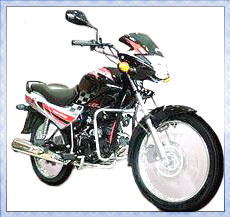Yes the Yamaha R1 and MT01 are finally launched in India. Both are six-gear road machines and share the same ex-showroom price at Rs10.5 lakh each. The bikes are available in New Delhi, Chennai, Bangalore and Ahmedabad initially.
“We are also planning to market these bikes in Mumbai, Pune and Chandigarh in the near future. In fact, we plan to sell these bikes in 10 cities within six months. We have a network plan to distribute these bikes through 50 outlets across the country by 2010”
said P. Sam, Yamaha Group head, marketing & sales. on the sidelines of the launch. The company has annual target of selling 400 to 500 units of the newly launched machines.
Both bikes are amongst the best Yamaha has to offer. The R1 is all about power and speed, while the MT01 has loads of torque.
 Specs:-
Specs:-
Model name YZF-R1
Dimension&Weight
Overall length 2060mm
Overall width 720mm
Overall height 1110mm
Seat height 835mm
Wheelbase 1415mm
Minimum ground clearance 135mm
Dry(without oil and fuel) 177kg
Wet(with oil and a full fuel tank) 200kg
Performance
Top speed 285km/h
Minimum turning radius 3.4m
Engine Performance
Engine type Liquid cooled 4-stroke DOHC4-valve
Cylinder arrangement Forward-inclined parallel 4-cylinder
Displacement 998cm3
Bore & stroke 77 0 X 53.6mm
Compression ratio 12 7 : 1
Maximum horse power 132.4kW(12500r/min)
Maximum torque 112.7N・m(10000r/min)
Starting system type Electric starter
Lubrication system Wet sump
Radiator capacity(including all routes) 2.51L
Engine oil capacity 3.83L
Fuel
Air filter type Paper
Fuel tank capacity 18L
Electrical
Ignition system type T C I
Spark plug model CR9EK
Battery voltage/capacity 12V, 8.6AH(10H)
Transmission
Primary reduction ratio 65/43 1.512
Secondary reduction system Chain drive
Secondary reduction ratio 45/17 2.647
Clutch type Wet,multiple-disc coil spring
Gear ratio
Transmission type Constant mesh 6-speed
Gear ratio-1st gear 38/15 2.533
Gear ratio-2nd gear 33/16 2.063
Gear ratio-3rd gear 37/21 1.762
Gear ratio-4th gear 35/23 1.522
Gear ratio-5th gear 30/22 1.364
Gear ratio-6th gear 33/26 1.269
Chassis
Frame type Diamond
Tire size(Front) 120/70ZR17MC(58W)
Tire size(Rear) 190/50ZR17MC(73W)
Brake
Disc effective diameter(Front) 283mm
Disc effective diameter(Rear) 186mm
Suspension
Suspension type(Front) Telescopic fork
Suspension type(Rear) Swingarm
Shock absorber
Shock absorber assembly type(Front) Coil spring/oil damper
Shock absorber assembly type(Rear) Coil spring/gas-oil damper
Wheel travel(Front) 120mm
Wheel travel(Rear) 130mm
Bulbs(voltage/wattagex quantity)
Headlight bulb type Halogen bulb
Headlight 12V, 55W ×4
Auxiliary light 12V, W5W ×2
Brake/tail light LED, 12V 2.3W/0 2W
Turn signal light(Front) 12V, R10W ×2
Turn signal light(Rear) 12V, R10W ×2
Meter
Speedometer LCD Digital
Tachometer Analog
Odometer LCD Digital
Trip meter LCD Digital
Water temperature meter LCD Digital
Clock LCD Digital
 Model name MT 01Dimension&Weight
Model name MT 01Dimension&WeightOverall length 2185mm
Overall width 800mm
Overall height 1105mm
Seat height 825mm
Wheelbase 1525mm
Minimum ground clearance 145mm
Dry(without oil and fuel) 243kg
Wet(with oil and a full fuel tank) 262kg
PerformanceMaximum speed (crouched) 210km/h
Minimum turning radius 3.2m
Engine PerformanceEngine type Air cooled 4-stroke,OHV
Cylinder arrangement V-type 2-cylinder
Displacement 1670cm3
Bore & stroke 97 X 113mm
Compression ratio 8.4 : 1
Maximum horse power 66.3kW(4750min-1)
Maximum torque 150.3N・m(3750min-1)
Starting system type Electric starter
Lubrication system Dry sump
Engine oil capacity 5.0L
Fuel Air filter type Oil-coated paper element
Fuel tank capacity 15.0L
ElectricalIgnition system type TCI
Spark plug model DPR7EA9/X22EPR-U9
Battery voltage/capacity 12V, 12AH
TransmissionPrimary reduction system Gear
Primary reduction ratio 71/48 1.479
Secondary reduction system Chain
Secondary reduction ratio 39/17 2.294
Clutch type Wet,multiple-disc
Gear ratioTransmission type Constant mesh 5-speed
Gear ratio-1st gear 38/16 2.375
Gear ratio-2nd gear 30/19 1.579
Gear ratio-3rd gear 29/25 1.160
Gear ratio-4th gear 24/25 0.960
Gear ratio-5th gear 24/30 0.800
Chassis Frame type Double Cradle
Tire size(Front) 120/70 ZR17 M/C (58W)
Tire size(Rear) 190/50 ZR17 M/C (73W)
BrakeEffective radius of disc(Front) 283.0mm
Effective radius of disc(Rear) 238.0mm
SuspensionSuspension type(Front) Telescopic fork
Suspension type(Rear) Swingarm(link-suspension)
Shock absorberShock absorber assembly type(Front) Coil spring/oil damper
Shock absorber assembly type(Rear) Coil spring/gas-oil damper
Bulbs(voltage/wattagex quantity)
Headlight bulb type Halogen bulb
Headlight 12V, Lo;51W ×1 / Hi;55W ×1
Auxiliary light 12V, 5W ×3
Brake/tail light 12V 2.0/0.2W LED
Turn signal light(Front) 12V, 10W ×2
Turn signal light(Rear) 12V, 10W ×2
MeterSpeedometer Digital
Tachometer Analog
Odometer Digital
Trip meter Digital
Clock Liquid crystal Digital














































